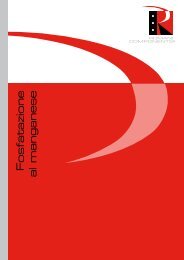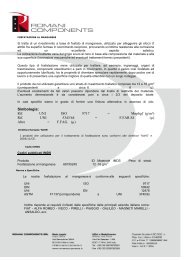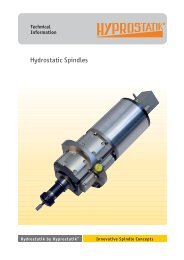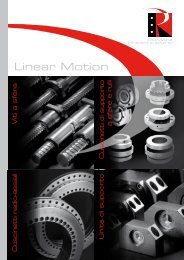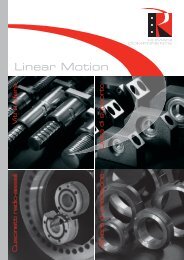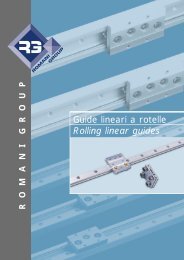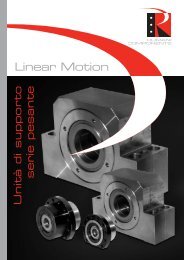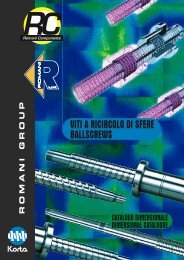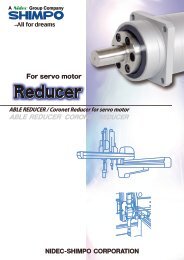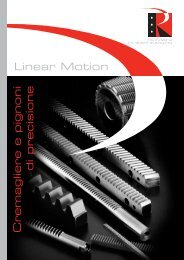Higher Speed and Extended life 2Lower torque, noise and vibration
Higher Speed and Extended life 2Lower torque, noise and vibration
Higher Speed and Extended life 2Lower torque, noise and vibration
You also want an ePaper? Increase the reach of your titles
YUMPU automatically turns print PDFs into web optimized ePapers that Google loves.
<strong>Higher</strong> <strong>Speed</strong> <strong>and</strong> <strong>Extended</strong> <strong>life</strong><br />
- DN factor evolution<br />
- Test cycle<br />
- Results comparison<br />
DN factor evolution<br />
New hibrid design with optimal recirculation system<br />
<strong>and</strong> NTG treatment improves results achieving up<br />
to DN 160.000.<br />
internal (dn=100000)<br />
external (dn=120000)<br />
high speed (dn=160000)<br />
Rotational speed (RPM)<br />
5800<br />
5200<br />
4600<br />
4000<br />
3400<br />
2800<br />
2200<br />
1600<br />
1000<br />
30 40 50 60 70 80<br />
Shaft diameter (mm)<br />
Wear influence in the <strong>torque</strong><br />
This chart shows the relation between wear<br />
of the different components of a ballscrew<br />
<strong>and</strong> its <strong>torque</strong> variation:<br />
- After 100 hours travel the conventional<br />
ballscrew lose 30% of its <strong>torque</strong> while with<br />
High <strong>Speed</strong> design only a 6%.<br />
Conventional <strong>torque</strong><br />
Conventional wear<br />
High speed <strong>torque</strong><br />
High speed wear<br />
Torque (Nm)<br />
0.9<br />
0.85<br />
0.8<br />
0.75<br />
0.7<br />
0.65<br />
0.6<br />
0.55<br />
0.5<br />
0 20 40 60 80 100<br />
Time (h)<br />
6<br />
5<br />
4<br />
3<br />
2<br />
1<br />
0<br />
-1<br />
Wear (µm)<br />
<strong>Speed</strong> (m/sec)<br />
0.75<br />
0.25<br />
1<br />
0.5<br />
0<br />
0 1 2 3 4<br />
Time (sec)<br />
Results comparison<br />
Diam=40<br />
Lead=12<br />
4000 RPM<br />
a=1G<br />
DN=160000<br />
Test cicle<br />
High <strong>Speed</strong> <strong>life</strong> test cycle used to compare<br />
conventional with KORTA High <strong>Speed</strong> ballscrews.<br />
Noise level dB (A)<br />
90<br />
85<br />
80<br />
75<br />
70<br />
65<br />
60<br />
55<br />
50<br />
45<br />
600 1350 2100 2850 3600<br />
Rotational speed (RPM)<br />
High speed<br />
Conventional<br />
Measured <strong>noise</strong> level<br />
Noise level comparison between a conventional<br />
<strong>and</strong> a High <strong>Speed</strong> design ballscrew:<br />
- A microphone placed at 500 mm distance<br />
records a gap of 10 dB(A) between both types<br />
of ballscrews.<br />
Slight marks appear after 180 km travel in conventional Normal<br />
ballscrews, in High <strong>Speed</strong> design marks do not appear Flaking 33%<br />
until 2.180 km.<br />
Critical<br />
Flaking occur arround 33% of the screw shaft in<br />
conventional ballscrews after 1,000 km travel, in High<br />
<strong>Speed</strong> design after 4.000 km travel.<br />
Nut deterioration occur after 1.500 km travel in<br />
0 600 1200 1800 2400 3000 3600 4200<br />
conventional, in High <strong>Speed</strong> after 4.200 km.<br />
Distance (Km)<br />
High <strong>Speed</strong> ballsrews follow up beyond 4.200 km travel.<br />
<strong>2Lower</strong> <strong>torque</strong>, <strong>noise</strong> <strong>and</strong> <strong>vibration</strong><br />
- Torque chart<br />
- Wear influence in the <strong>torque</strong> - Vibration chart<br />
- Measured <strong>noise</strong> level<br />
- Frecuency chart<br />
Vibration chart<br />
- High <strong>Speed</strong> ballscrews show 8 times less amplitude<br />
than conventional ballscrews.<br />
- The contact among the balls <strong>and</strong> the groove is reduced<br />
using ceramic balls, specific design of the recirculating<br />
system <strong>and</strong> high quality finishing of rolling surface.<br />
- In order to measure the <strong>vibration</strong> an accelerometer<br />
is installed radially in the nut.<br />
High speed<br />
Conventional<br />
Torque chart<br />
Torque chart<br />
Dynamic friction <strong>torque</strong> comparison between a High <strong>Speed</strong><br />
design <strong>and</strong> a conventional ballscrew at 10 RPM, grease<br />
lubrication <strong>and</strong> 100 hours travel:<br />
- Conventional ballscrews lose <strong>torque</strong>.<br />
- High <strong>Speed</strong> ballscrews run without any spike generation or<br />
jamming. Torque fluctuation is low.<br />
Frecuency chart<br />
- The accelerometer signal is continuously monitorized.<br />
- Frecuency analizer software performs a complex data<br />
analysis.<br />
- Different modules provide main features for <strong>vibration</strong><br />
<strong>and</strong> frecuency analysis.
3- Treatments comparison<br />
- Mean wear of the components<br />
Lower heat generation <strong>and</strong> less lube needed<br />
- Heat generation<br />
- Required lubrication comparison<br />
High <strong>Speed</strong> Ballscrews<br />
Treatments comparison<br />
- Korta NTG surface treatment applied to High <strong>Speed</strong> design<br />
ballscrews increases hardness <strong>and</strong> wear resistence reducing<br />
frictional coefficient.<br />
- Korta NTG treatment results 2 times better than nitriding<br />
<strong>and</strong> 10 times better than conventional surface treatment.<br />
Korta NTG<br />
Nitriding<br />
Conventional<br />
Wear average<br />
100%<br />
80%<br />
60%<br />
40%<br />
20%<br />
0%<br />
Pitting (p/1000)<br />
7<br />
6<br />
5<br />
4<br />
3<br />
2<br />
1<br />
0<br />
0 1000 2000 3000<br />
Distance (Km)<br />
High speed<br />
Conventional<br />
Mean wear of the components<br />
In order to measure the mean wear of the components<br />
in a ballscrew, stress corrosion <strong>and</strong> cracking induced from<br />
the combined influence of tensile stress <strong>and</strong> corrosive<br />
enviroment are taken into consideration.<br />
Several wear parameters are recorded at different travel<br />
distances.<br />
Ballscrew groove wear after 1.500 km. travel<br />
Balls wear after 1.500 kn. travel<br />
Conventional Ballscrew<br />
High <strong>Speed</strong> Ballscrew<br />
Steel Balls<br />
Ceramic Balls<br />
Heat generation<br />
Conventional High <strong>Speed</strong><br />
Temperature generated 82 ºC 47 ºC<br />
Temperature increase 62 ºC 27 ºC<br />
High speed<br />
Conventional<br />
Temperature (ºC)<br />
100<br />
80<br />
60<br />
40<br />
20<br />
0<br />
0 100 200 300 400<br />
Cicles<br />
500<br />
100%<br />
80%<br />
60%<br />
40%<br />
20%<br />
0%<br />
Conventional Ballscrew<br />
High <strong>Speed</strong> Ballscrew<br />
Initial lubrication<br />
Travel lubrication<br />
Required lubrication comparison<br />
The necessary rate of lubricant is in close relation with<br />
working temperatures.<br />
A raise in temperature increases need of lubricant supply:<br />
- At the initial 100 cycles the estimated lubricant supply<br />
for a conventional ballscrew is 4 times higher than for a<br />
High <strong>Speed</strong> ballscrew.<br />
- At the end of the test the amount of lubricant used for<br />
a High <strong>Speed</strong> ballscrew is 5 times less than for a<br />
conventional ballscrew.<br />
DN=160.000<br />
New Korta "NTG" Treatment<br />
Hybrid Design<br />
KORTA S.A. Joxe Mari Korta Industrigunea, 2, - Apdo. 6 - 20750 ZUMAIA (Gipuzkoa) Spain<br />
Tel.: (34) 943 86 03 62 / 66 - Fax: (34) 943 86 01 42 - e-mail: info@korta.com<br />
www.korta.com



